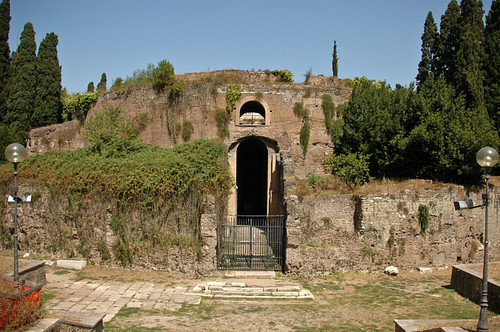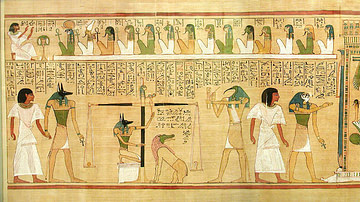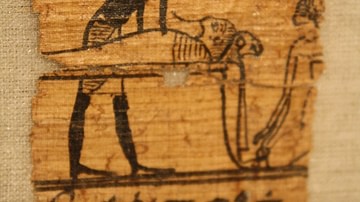The Mausoleum of Augustus was actually one of the first of many large building projects undertaken in the reign of Rome's first emperor. When the Mausoleum was completed in 28 BCE, it was easily the biggest tomb in the Roman world, a record it held throughout the Roman period. Now a ruin situated in Piazza Augusto Imperatore near the river Tiber, this once magnificent circular edifice stood around 45 metres high and almost 90 metres in diameter. Within were interred not only the remains of Augustus himself but also other prominent members of the imperial family including his two sons and later emperors such as Tiberius, Nero and Nerva.

Dimensions
The Mausoleum was described by Strabo, who likened it to a huge mound or tumulus, all white and surrounded by trees. From his visit in 7 BCE he also mentions that on the top of the dome was a bronze statue of Augustus. The Mausoleum, then, was a circular building with a diameter of 300 Roman Feet or around 89 metres. The precise height of the structure is not known as the upper portions of the Mausoleum have not survived. Most likely with a single domed roof or a stepped dome with a small domed barrel in the centre, the overall height of the building may have reached 150 RF or between 40 and 45 metres. The external wall alone was 40 RF or around 12 metres high. The ruins today only reach a height of 30 metres.
Materials & Layout
The building was constructed using concrete and large limestone (travertine) blocks for the core of the structure, tufa rubble as filler material, and white limestone for the facing. The inner concrete walls are arranged in three concentric circles and attached via semi-circular buttresses to the external wall for extra support. This complex arrangement meant the four walls were, collectively, an impressive 25 metres thick. The Mausoleum had only a single entrance which faced the Field of Mars and gave access via a short corridor to an inner circle corridor which was vaulted. This inner circle wall had two entrances placed side by side which gave access to another circular corridor and the small inner burial chamber, once again circular but with a concrete central column. The interior walls of this chamber had three rectangular recesses for the placement of funerary urns. The central column also had a recess, this time square and probably reserved for an urn containing the ashes of Augustus himself.
A Family Mausoleum
The building was perhaps influenced by, or Augustus may even have wished to rival, the tombs of those other legendary rulers in antiquity King Mausolos of Caria at Halicarnassus and Alexander the Great in Egypt. The very shape of the structure - a huge mound - also recalls the traditional tombs of the Bronze Age such as those at Troy, from where the Julian family claimed ancestry. The Mausoleum was designed to hold members of this family and those interred within it included Augustus' nephew Marcellus (died 23 BCE), his son-in-law Marcus Agrippa (12 BCE), Drusus the Elder (9 BCE), Augustus' two sons Lucius and Gaius Caesar (2 and 4 CE respectively), and the emperor himself in 14 CE. Then followed a long line of relations and associates including Drusus the Younger, Livia, Tiberius, Agrippina, Nero, Drusus (brother of Caligula), Poppaea, and Nerva.
On the death of Augustus two bronze plaques were placed on either side of the Mausoleum entrance. These were inscribed with the emperor's lifetime achievements, his Res Gestae. Around the 4th century CE two red Aswan granite obelisks were erected either side of the entrance. These were later removed, one to stand outside the church of S.Maria Maggiore on the Esquiline and the other to be integrated into the Horse fountain in Piazza del Quirinale.
![Mausoleum of Augustus [Rear View]](https://www.worldhistory.org/img/r/p/500x600/4477.jpg?v=1618582532)
Later History
As with many other Roman monuments the Mausoleum was converted into a fortress in the Middle Ages, this particular one by the Colonna clan. The fortress was subsequently broken down in 1167 CE and many of the stones, especially the large outer travertine blocks, were recycled for use elsewhere. Faring slightly better in the 16th century CE, the Soderini clan made the now flat rooftop into an ornamental garden. This was changed once again in the 18th century CE into a bull-fighting arena and, later, a site for circus acts. Finally, the early 20th century CE saw the building converted into a concert hall before an interest in ancient Rome in the fascist era led to the stripping away of all later additions. The ruined building spent the rest of the 20th century casting a somewhat forlorn figure of overgrown grass and dishevelled-looking cypress trees, its steadily crumbling interior walls only hinting at the former glory of this once great monument to Roman vanity. Fortunately, the mausoleum has fared better in the 21st century and a major restoration project, completed in 2021, has permitted the building to be opened to the public.





